
views
Opening with a Quote, Definition, or Fact
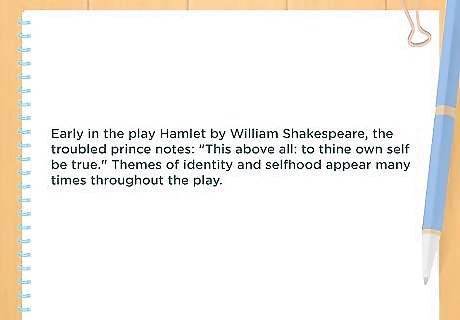
Pick a short quote from the text that relates to your topic. The quote should explore your topic in detail or expand on the theme of your paper. It can also provide background information on your topic. Try to find a quote from the text you are discussing in your paper, or from a supporting text. For example, you may pick a bold quote from a play by Shakespeare you are discussing to open the essay so your reader is drawn in. You may write, “Early in the play Hamlet by William Shakespeare, the troubled prince notes: ‘This above all: to thine own self be true.’ Themes of identity and self-hood appear many times throughout the play.” Always cite any quotes you use in your introduction using the proper citation style, according to your instructor’s requirements for your paper or essay.

Avoid quotes that are clichés or overly familiar. Stay away from quotes that are too vague and do not relate to your topic, such as “Life is hard” or “Love is blind.” Instead, use a quote that puts a new spin on a cliché or relates to your topic in a detailed, specific way. For example, you may write, “In Shakespeare’s Othello, love is not blind, it is all seeing. As Othello notes, ‘For she had eyes and she chose me.’”

Use a startling fact. Pick a fact that your reader will find shocking or troubling. Find a fact in your sources or the text you are discussing. The fact may include statistics and data that will be surprising to readers. For example, you may write, “Every year, 25,000 people die due to drunk driving in the United States” or “One in five women will be raped in the United States.”

Paraphrase a definition. Definitions straight from the dictionary can be dry and boring. Take a standard definition and paraphrase it. Write it in your own words so it sounds more interesting to readers. For example, you may write, “When the city gentrifies an area, it renovates and improves a neighborhood so it conforms to middle-class tastes.” Or you may write, “When an area is gentrified, it becomes more refined and polite for some, but not all.”
Beginning with a Question or Statement

Make the question provocative and thought-provoking. Start the question with “What if,” “Why,” or “How.” The question should relate to the topic, theme, or idea of your essay. It should draw the reader in and make them think. For example, you may use a question like, “What if we lived in a world where women were not constantly under threat of violence?” or “Why shouldn’t everyone have access to free healthcare in America?”
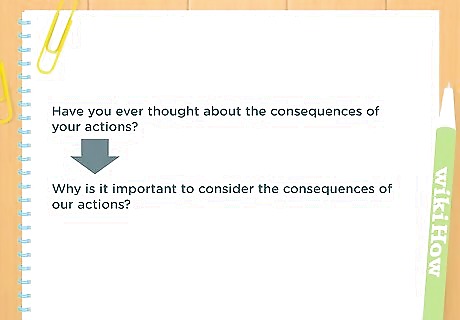
Avoid “yes” or “no” questions. Questions that can be answered with a “yes” or “no” are usually too obvious and general. You also run the risk of the reader answering “no” to your question and not reading the rest of your essay or paper. For example, rather than start with a question like, “Have you ever thought about the consequences of your actions?” you may rephrase it as, “Why is it important to consider the consequences of our actions?”

Use a statement that describes your perspective. Sum up your perspective in a short, declarative statement. Discuss your perspective on the text you are discussing as well as a key point that will help to frame your essay or paper. For example, you may write, “Shakespeare’s Othello is a play about the doomed nature of love and the power of desire.” Or you may write, “Drunk driving is an epidemic in America that seems to only get worse every year.”
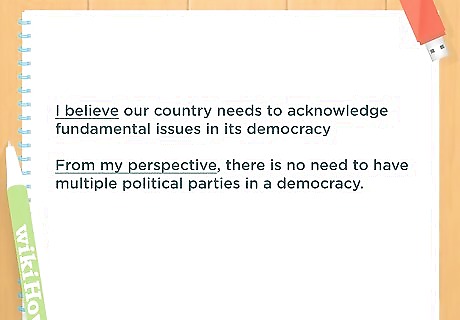
State your opinion with “I believe” or “From my perspective.” Do this if you are writing an opinion piece or a personal essay. For example, you may write, “I believe our country needs to acknowledge fundamental issues in its democracy” or “From my perspective, there is no need to have multiple political parties in a democracy.”
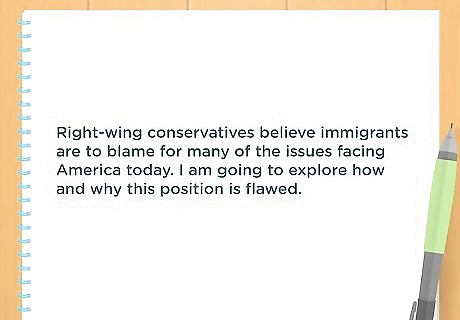
Write a statement that discusses a position you are going to challenge. Open with a statement that presents a position that is the opposite of your own. You can then explore how and why you oppose this position in your essay. This a good way to open with a bang and get your reader to pay attention. For example, you may write, “Right-wing conservatives believe immigrants are to blame for many of the issues facing America today. I am going to explore how and why this position is flawed.”
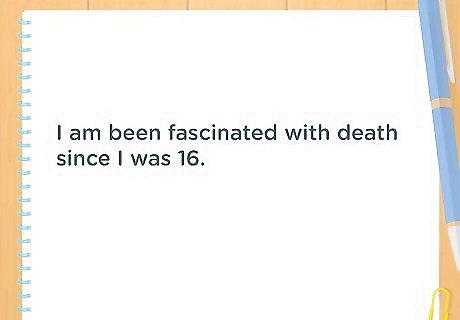
Start with an exaggerated or hyperbolic statement. This is a good option if you are writing a personal essay or an opinion piece. Exaggerate details of the story to pull the reader in. Paint a visual picture in the reader’s mind using a statement that is a little over the top. For example, you may write, “I am been fascinated with death since I was 16” or “There is no greater joy to me than an empty bed where I can be alone, away from the world.”
Using Storytelling

Tell a personal anecdote that relates to your topic. Pick an anecdote that will introduce your topic to the reader through setting, scene, and detail. Guide the reader through the story so they are drawn in. Try to keep the anecdote short and to the point, around two to four lines at the most. For example, you may write, “The other day in the supermarket, I heard a child talking to his mother. ‘Why aren’t we getting the ones with marshmallows in them?’ he demanded, pointing at the boxes of cereal. He threw a tantrum in the aisle until his mother relented, throwing the sugary cereal into their cart. Standing in the aisle, watching the child, I couldn’t help but think about how children’s diets are becoming more and more unhealthy.”
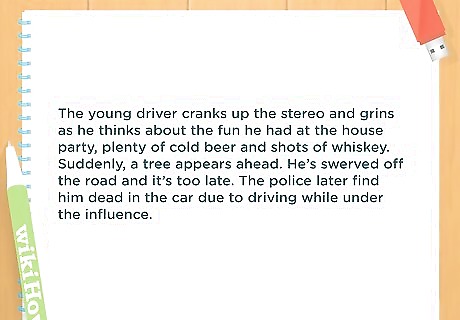
Make a statistic or fact come to life in a story. Take a fact or statistic about your topic and write it as a story. Get into the perspective of someone mentioned or referred to in the statistic or fact. Describe the sights, sounds, and emotions the person might be feeling in the story. For example, you may take a fact about drunk driving and write a short story like, “The young driver cranks up the stereo and grins as he thinks about the fun he had at the house party, plenty of cold beer and shots of whiskey. Suddenly, a tree appears ahead. He’s swerved off the road and it’s too late. The police later find him dead in the car due to driving while under the influence.”
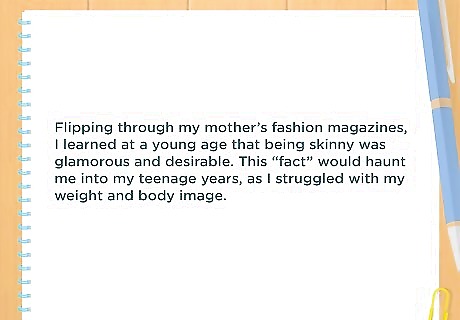
Use an emotional experience in your life. If you are writing a personal essay or an opinion piece, you can draw on the reader’s emotions by focusing on an experience in your life that was intense and overwhelming. You may pick an experience from childhood or a moment in the recent past that was charged with emotion. For example, if you are writing about eating disorders in fashion, you may describe your own experiences with body image. You may write, “Flipping through my mother’s fashion magazines, I learned at a young age that being skinny was glamorous and desirable. This “fact” would haunt me into my teenage years, as I struggled with my weight and body image.”


















Comments
0 comment